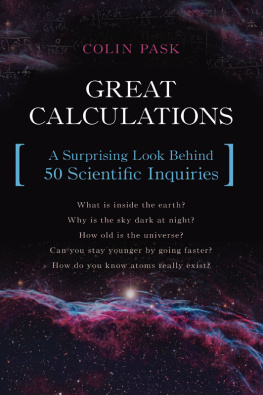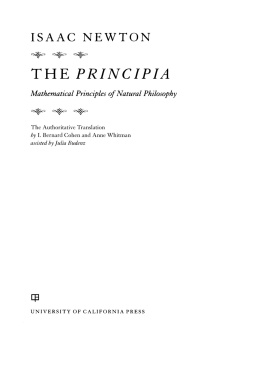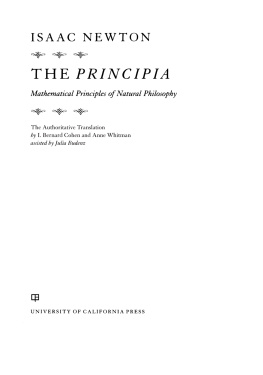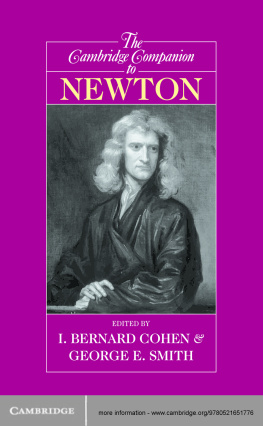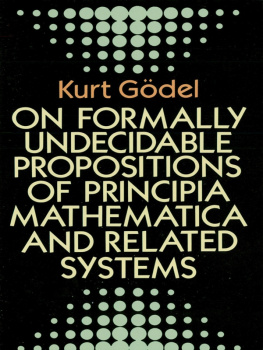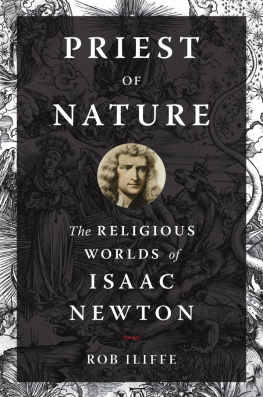
This book began life in material used for public lunchtime lectures and in undergraduate lecture courses. I thank everyone who discussed the subject with me and made useful suggestions. I am greatly indebted to Peter McIntyre and Ravi Sood for their careful reading of the manuscript and giving me many corrections and suggestions for improving the text. Of course, the remaining errors are entirely my own. Other colleagues supplied advice and ideas and, most importantly, encouragement to continue when I was struggling. Great thanks are due to the wonderful Annabelle Boag for turning my rough sketches into beautiful figures. (Unless otherwise indicated, the figures in this book have been created by her.) Much must be done to turn a manuscript into a polished book, and I wish to thank Mariel Bard for her meticulous editorial work and for her patience in dealing with an inexperienced author. Many scholars have studied Newton and his work, and I have made great use of their writings, as explained in my preface.
It is over fifty years since I first met Johanna, and she remains my greatest love and inspiration. Quite simply, without her, this book would not exist.

It is virtually impossible to read the Principia without thinking about just what sort of man could have written it. Furthermore, there are places where knowing something of the nature of the author makes it easier to understand why certain topics and approaches are discussed. So a brief introduction is in order. It would be impossible to cover Newton and his life in detail here; therefore, this sketch is more in the nature of scene setting, with suggestions for further reading at the end.
In 1927, on the two hundredth anniversary of the death of Isaac Newton, Einstein wrote that we feel impelled at such a moment to remember this brilliant genius, who determined the course of western thought, research, and practice like no one else before or since.
What sort of a man could have gained such a reputation? Was he a boy genius, like Mozart, taught and encouraged by a talented father? No; there was nothing in Newton's origins to indicate that he would become the man who changed our view of the world and set us on the pathway to modern science.
1.1. ORIGINS
Hannah Newton gave birth to son Isaac on Christmas Day 1642. (A table of important dates in Newton's life is given at the end of the chapter.) The birthplace was a manor house at Woolsthorpe, about seven miles south of the midlands town of Grantham in Lincolnshire (see unlikely start for the man who was to die eighty-four years later revered as the greatest man of his times.
Three years later, Hannah married the reverend Barnabas Smith and moved to the rectory in nearby North Witham. Isaac was left with his maternal grandmother, Margery Ayscough, until 1653, when Barnabas Smith died and Hannah moved back to Woolsthorpe with her three Smith children. The young Isaac did not have a fond relationship with his grandmother, and grandfather Ayscough left him out of his will. Between the Newtons, Ayscoughs, and Smiths, there was a rising level of prosperity, so Isaac grew up in relatively well-off circumstances.
It seems that Isaac was destined to take over the family farming business, but there were educated members on the Ayscough side of the family and, after a little time in a nearby village school, Isaac was sent to the Free Grammar School of King Edward VI (also called the King's School) in Grantham. Isaac was now twelve and lodged with Joseph Clark, an apothecary. Latin was a major subject, which was lucky for Isaac, as Latin was something of a universal language of science at the time. It is possible that the school's headmaster, Mr. Stokes, may have been interested in mathematics and helped Isaac along that road too. There is evidence of Isaac's skills at making models of all kinds and at drawing.
In 1659, as he was approaching seventeen, Isaac was taken home by his mother to learn how to run the estate and gain some farming experience. By all accounts, this was not a success and Isaac neglected his duties in favor of things like model building and reading. The situation must have been summed up by his uncle Reverend William Ayscough, who urged that Isaac be sent back to school to prepare for university studies. Headmaster Stokes also told Newton's mother that such talents should not be buried under various rural pursuits. It worked, and in 1660, Isaac returned to school in Grantham, although none could have guessed what a critical and momentous step that was.
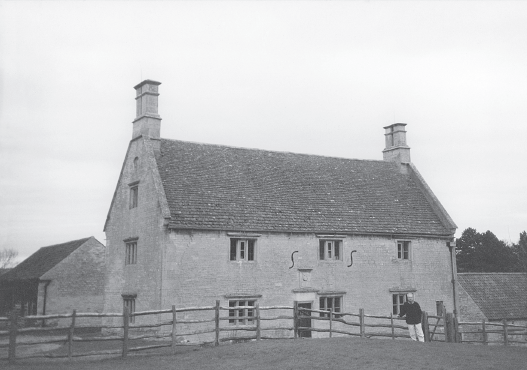
Figure 1.1. The author seeks inspiration at Newton's birthplace. (Photograph by Johanna Pask.)
1.2. A LIFE AT CAMBRIDGE
Isaac Newton finally escaped rural life in June 1661 when he entered the University of Cambridge. He would remain at Cambridge first as a student, then as a fellow and as a professor for the next thirty-five years. Newton was exposed to a variety of subjects as a student, but most importantly he studied mathematics and science with great intensity and was largely self-taught in many important areas. He graduated with a bachelor of arts degree in early 1665.
An outbreak of the plague caused a closure of the university, and Newton spent most of 1665 to 1668 back in the quiet of farms in Lincolnshire. Here came the famous anni mirabiles when Newton developed so many of his early, brilliant ideas in mathematics, optics, and mechanics. As the plague subsided, Cambridge University reopened in spring 1667 and Newton returned to be made a fellow of Trinity College. Two years later, at the age of just twenty-six, he was appointed as the Lucasian Professor of Mathematics. This gave Newton security in his position and the chance to devote his life to study and research. The chair came with an income of one hundred pounds per annum and, on top of that, he had income from his fellowship and from the Lincolnshire estate. His required duties were comparatively light, with one lecture per week to be given for three terms. Ten lectures had to be deposited in the university library each year. Newton does not seem to have been an inspiring lecturer, and it is said that sometimes he gave the lectures to an empty room. (What would you or I give now to have heard a lecture by Isaac Newton!)
Newton continued his mathematical studies and teaching, although little was published. He was also working on optics, and his invention of the reflecting telescope was an early triumph. It was presented to the Royal Society in late 1671, and Newton was made a fellow in 1672 with seven of his papers published by the society that year. In 1672 he published Light and Colours, which described his theories on those subjects, and his Hypothesis Explaining the Properties of Light was published in 1675. But it was not until 1704 that the comprehensive treatise Opticks appeared. Newton now had the opportunity to mix and interact with major figures like Robert Boyle, but around this period, he also spent much time in secret work in alchemy and religious studies, interpreting the various versions of the Bible and evaluating chronological studies of ancient kingdoms.
The year 1679 marked important changes in Newton's life. He returned to Woolsthorpe to nurse his dying mother and spent much of the year attending to family affairs after her funeral in June. Later in the year, correspondence began between Robert Hooke and Newton on questions about planetary motion. In the years 16811682 Newton observed comets (that in 1682 being the famous Halley's comet), and his interest in dynamics was increasing. All of this was to culminate in the publication of the first edition of the
Next page

